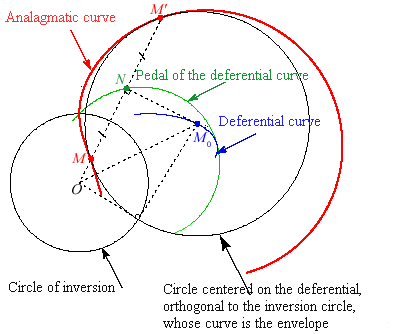| next curve | previous curve | 2D curves | 3D curves | surfaces | fractals | polyhedra |
ANALLAGMATIC CURVE
| Notion studied by Moutard in 1864.
Anallagmatic literally means: without change (from the Greek allagma "change"). |
| General polar equation: |
A curve is said to be anallagmatic if it is globally invariant by inversion.
Any anallagmatic curve can be generated as a cyclic curve, i.e. as the envelope of circles, orthogonal to the circle of inversion (in the case of a positive power), the centres of which describe one of the deferential curves of the curve (in the plural form, because we can indeed have several generations of this type there):

In the algebraic case, it is always circular.
Examples of anallagmatic curves:
- the straight line (with respect
to one of its points)
- the circle
- the strophoids
(the circle of inversion is centered at the focus (on the loop) and pass
by the double point, the deferential curve is a parabola passing by the
double point).
- More generally all circular
cubics (the pole of inversion is the point of the cubic where the tangent
is parallel to the real asymptote).
- the Pascal's
snails (with respect to the point of abscissa
on Ox).
- the Casinian
and Cartesian ovals.
- more generally the bicircular
quartics and circular ones with double point.
- anallagmatic
spirals.
| next curve | previous curve | 2D curves | 3D curves | surfaces | fractals | polyhedra |
© Robert FERRÉOL
2016